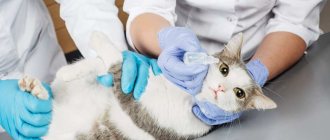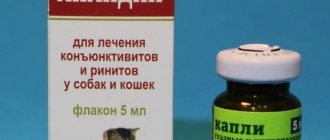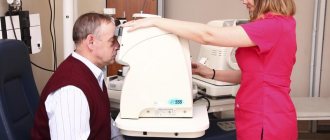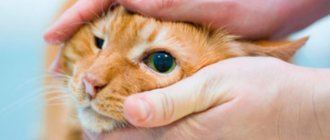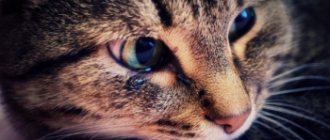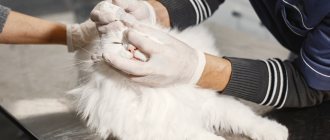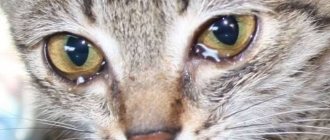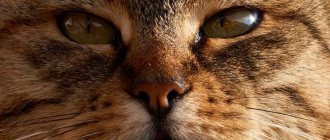The correct technique for administering ophthalmic drops to a cat will help counteract the development of eye diseases in the animal. Preparing your pet for the process by stroking and talking will help avoid stress. It is also important to cleanse your vision before the procedure. Drops are instilled into the conjunctival sac, retracting the eyelid. And after instillation, hold the cat so that it does not scratch its eyes, injuring them. Timely and proper treatment of the cat’s visual organs will reduce the likelihood of vision deterioration and improve the condition. But ignoring a trip to the veterinarian can lead to blindness. The veterinarian will examine the organs and recommend the correct treatment with the right drug and dosage.
Preparing the owner and cat for a medical procedure
Before the procedure, the animal owner must thoroughly wash their hands, disinfect them and wear gloves. There must be a mask on the face.
For a cat you need to prepare everything you need:
- warm boiled water;
- clean soft towel;
- a syringe without a needle or a pipette;
- 2 sterile cotton swabs (for each eye).
The drug must be removed from the cat's field of view. First, taking her in your arms, you need to calm her down, stroke her, and talk to her in a gentle voice. The animal must be securely restrained. A calm cat can be held in your arms or simply pressed lightly against the sofa. A restless one can be wrapped in a towel, leaving only the face visible.
It is good to attract an assistant who will hold the pet or instill medicine.
Features of the procedure
There are no fundamental differences in washing the eyes of an adult animal or a kitten: the procedure for performing the procedure is almost identical. The difference lies in small nuances that will help your pet as much as possible and not cause harm.
It all starts with preparing the necessary materials - you will need:
- several clean cotton pads or pieces of gauze;
- clean cloth napkins or towel;
- syringe without a needle (for copious rinsing);
- what you will use to wipe your cat’s eyes is a solution or decoction of herbs.
For aggressive or restless animals, a towel is useful - you can wrap the animal in it - or a retaining bag.
In adults
Adult cats may resist, so you will need an assistant to hold and calm the animal. The cat must be wrapped in a towel or blanket to gently hold it and not harm it during the procedure. Once the animal has been secured, you can begin washing.
First you need to soak the dried crusts, if any. After dipping a cotton pad into the medicinal solution, you need to squeeze the product into the sore eye and wait until the crusts become softer and easier to remove. Gently wipe the disc over the eyelid, being careful not to touch the cornea. Movements should be directed from the ears to the nose, towards the tear duct. Use different pads on different eyes to avoid infection of the healthy eye.
Once the eyes are clean, pour the medicinal solution onto the cornea of the eye using a syringe without a needle - if required by treatment. Normal hygienic cleaning can be left without this step. Remove any remaining solution around the eyelids with a dry cloth or towel. Do not press and try not to touch the eyeball with the tissue so as not to injure it or cause irritation.
How to wash a kitten's eyes
Kittens do not always cope well with washing themselves, as they are accustomed to the mother cat taking care of hygiene. In the first few months, the owner needs to regularly wash the baby’s eyes so that they do not begin to stick together and fester.
The whole manipulation is almost identical to what is done for an adult cat.
However, the procedure should be performed with extreme caution so as not to harm the small pet. You can do without an assistant - you can handle the baby yourself, especially if he is still sleepy
But after eating, you should not carry out the procedure - the kitten may vomit.
If, in addition to rinsing, there is a need to instill medicinal solutions or apply ointments, then precautions should be taken. Unlike adult cats, kittens should not have medicinal solutions put into their eyes immediately after rinsing: you must wait about ten minutes to minimize the risk of irritation.
If you have never owned a cat and do not know how and what to wash a kitten’s eyes with, contact your nearest veterinary clinic or an experienced breeder. You will quickly be shown all the steps of this easy and simple procedure.
Emotional mood
Do not forget to calm the cat throughout the procedure by talking affectionately to it. This works best if you imagine that in front of you is a very small child who does not yet speak, whom you persuade to eat another spoon “for dad” and “for mom.” At the same time, women instinctively raise their voices and develop gentle melodious intonations.
Naturally, you can say whatever you want and even perform children’s sayings and nursery rhymes - practice shows that they have the same calming effect on cats as they do on babies. Try not to be nervous yourself, behave calmly and confidently, and we hope our advice will help you with this.
How to wash the eyes of a kitten or cat as a preventive measure
It is recommended to monitor the condition of your cat's eyes from an early age. Newborn kittens' eyes open after one to two weeks.
If by the end of the third week the eyes have not opened, you need to wash them very carefully
Adult cats take care of their own hygiene. The daily cat ritual includes washing the face and eyes. But it happens that the cat gets hurt or catches a disease - to prevent complications, periodically examine your pet. If you notice clouding or change in color of the iris, purulent discharge, or fur on the face with traces of tears, then immediately contact your veterinarian. If an injury is detected, do not let the animal rub its eye, as this irritates the mucous membrane. Do not open your pet's eyes by force. Do not use medications containing prednisolone or dexamethasone yourself - you may worsen the situation.
The treating veterinarian will advise what to wash your cat's eyes with as a preventive measure. You can soak a cotton pad with strong tea or saline solution, and then clean the eye with smooth movements. All this is necessary if the cat periodically develops brown crusts - the consequences of poor hygiene and dust getting on the cornea. This is not dangerous if the accumulations are removed from the tear corners in time.
Do not forget to vaccinate your animal once a year, without losing track of the schedule. If you have an elderly or frail pet, take it to the veterinarian regularly.
In the case when simple medications do not help and your pet’s eyes continue to fester, become swollen and stick together, it is necessary to take the animal to the veterinarian. The doctor will make an accurate diagnosis and prescribe age- and breed-appropriate treatment.
The article is of a recommendatory nature. Consult your veterinarian!
Sequence of eye drops for a cat
Indications for eye treatment are pathological processes. For example, this is redness of the mucous membrane of the organ of vision, purulent discharge and gluing of the eyelids.
Before instilling medication into the eyes, you need to gently and carefully wipe the area around the eyes with swabs soaked in warm water to remove pus and other contaminants. Instead of water, you can use any warm tea or chamomile flower decoction.
Procedure:
- Rinse the mucous membranes of one eye first, and then the other with a cleansing solution. Remove wet residue.
- Open the tube with the pharmaceutical preparation.
- Slightly pull the eyelid down and squeeze 2-3 drops of the product into the resulting gap. During the procedure, you need to talk to the animal gently, this will calm him down.
- Massage the eyelid for 5-7 seconds for the best distribution of the medicine. The liquid should not leak onto the wool.
- Repeat the manipulation with the second eye. Do not let go of the animal for 2-3 minutes so that it does not scratch the eyeball.
The pet will feel itching or burning after the procedure. Sometimes the cat may feel severe pain. At this point she will become restless or even aggressive.
The animal needs to be rewarded with its favorite treat.
Is it possible to put human drops in a cat's eyes?
How to give eye drops to a cat?
Many people have pets that we take care of. But situations happen in life when your pet gets sick and this is very sad. And of all diseases, the most unpleasant and inconvenient disease to treat is eye disease. Most often, such diseases are very difficult and prevent the cat from enjoying life.
The eyes of a cat or cat can get sick for various reasons: bruises, injuries, debris stuck, previous diseases not treated and other reasons. Before starting treatment, all this must be taken into account. Because in order to get rid of and cure an insidious disease, you must first eliminate the cause of its occurrence.
Treating a cat is the same as treating a small capricious child. Your pet will not sit with his eyes open and wait until you finish all the procedures. It is quite natural that he will twitch, resist and run away. Therefore, to put drops in an animal’s eyes, you will have to work hard to catch him or her. And most likely it will not be so easy.
How to give eye drops to a cat? You caught your favorite cat, but at the same time you overturned all the furniture in the house, but this is just the beginning. To instill the drops themselves, you need medicine, a pipette and an assistant who will help hold your pet the way you need.
Be sure to warm the medicine before the procedure; you can simply hold it in your palms for a while, otherwise you yourself will understand what the cat’s reaction to the cold solution will be. Using gentle, gentle and careful movements, you must remove pus from the eyes, this must be done very carefully, and before the procedure itself, in order not to cause additional infection, you need to wash your hands. And if you have large nails, then ask another person to put drops in the animal, otherwise you may damage the cat's eye
Source
Thymogen
In fact, this medicine can be considered an analogue of Maxidin: the drug also has a pronounced immunomodulatory effect and has a beneficial effect on the pet’s immunity. The main active ingredient is alpha-glutamyl tryptophan. The product is gentle and very effective:
- It increases the speed of regeneration processes so much that it is recommended for use for ulcerative rhinitis.
- Significantly increases nonspecific resistance, which is why it is very effective in the treatment of pathologies of viral origin.
Two drops of the drug are instilled into each nostril. Frequency of use – once a day. The duration of treatment is up to five days in a row, but if necessary, this period can be significantly extended.
The principle of action of drops in case of a burst vessel
Important! Drops can restore the surface of the eyeballs. Each type of drug is used in certain cases, since drops are often able to relieve factors that contribute to the rupture of capillaries.
For example, constricting drops are used for blood pressure, colds or fatigue.
Broken blood vessels in the eye can occur due to serious diseases.
In this case, in addition to the use of drops, comprehensive treatment of the underlying ailment is necessary.
If the cause of this condition is overwork, tension, and other non-pathological factors, then it is quite possible to get rid of the problem with the help of eye drops.
They can be tonic and nutritious, containing many vitamins and minerals.
Animal care tips
When treating inflammatory eye diseases, animals are most often prescribed instillation - drip administration of solutions of medicinal agents. When instilling, it is necessary to correctly follow all the rules and recommendations of specialists on the administration of pharmaceuticals.
Only a veterinarian can prescribe medication correctly. A specialist should also monitor and adjust the dynamics of therapy. Uncontrolled or illiterate use of the drug can only worsen the situation. Medicines should not be expired.
Advice! The procedure should be carried out as naturally as possible, otherwise the animal will be scared and not allow the drops to be administered. The effectiveness of the manipulation will be much higher if the animal sits or lies in a calm state.
If the kitten cannot wash itself, then the owner should help it daily using boiled warm water or weak tea leaves.
Inflammation of the eyes is a common symptom in small kittens. A problem detected in time will help to avoid major health problems, and competent assistance will stop the development of the disease. The health of a pet primarily depends on its owner.
Indications for use
Veterinarians prescribe “Diamond Eyes” drops to cats for the treatment of ophthalmological ailments of various etiologies and genesis. Used for treatment:
- acute, chronic purulent, allergic, bacterial, catarrhal conjunctivitis;
- blepharitis;
- uveitis;
- keratitis;
- trichiasis;
- cataracts;
- age-related dystrophic changes in the cornea. lens
Eye drops are prescribed to animals with corneal ulcers, to eliminate post-traumatic inflammatory processes, when the eyes are infected with various foreign objects, and hyperemia of the blood vessels of the eyeball (red eye syndrome).
Conjunctivitis in a kitten
When used systematically, the drug eliminates inflammation of the mucous membrane, relieves pain and itching. They can be prescribed to relieve swelling, redness of the eyelids, excessive lacrimation, to relieve allergic reactions that are accompanied by increased formation of exudate, as well as in the postoperative period to prevent the development of eye infectious diseases.
Veterinarians recommend using diamond eyes for everyday hygiene (treatment, washing) of the eyes, removing exudate and dried crusts on the eyelids.
Ophthalmic drops can be used to treat eye diseases in cats and dogs of various age groups and breeds. Suitable for use by pregnant and lactating females.
Cold drops for cats - 4 different preparations
It's already 2022. The thermometer shows -18, so a person can easily catch a cold. This also applies to our pets. In this article I will talk about 4 drugs (drops) that treat a runny nose - the main symptom of a cold. But you can read about how to give medicine to an animal in our article “How to put drops on a cat’s nose.”
Anandin is available in different forms, but here Anandin is considered as eye-intranasal (nasal) drops. This drug has anti-inflammatory, antimicrobial and regenerative effects, stimulates the formation of T and B lymphocytes. It is used for a wide range of diseases, including colds. No allergic reactions were observed when using Anandin.
The main active ingredient is glucoaminopropylacridone (2%). And:
1 dose - 20 mg per 1 kg of cat weight. Place 2-4 drops into each nasal passage 2-3 times a day.
Store in a dry place, out of reach of children, protected from light. Temperature - from 0 to 25°C. Shelf life: 24 months (2 years).
Fosprenil is a modern antiviral drug that is used not only for treatment, but also for prevention. This remedy is very effective in the treatment of such serious diseases as panleukopenia, infectious peritonitis, calicivirus, and canine distemper. However, this efficiency comes at a price. Thus, fosprenil can be used as a cat nasal drop, but this can be expensive and the drug is not specialized for this disease.
The main active ingredient is disodium salt of polyprenols phosphate (400 mg). Excipients:
Kittens: single dose - 0.3 cm³/kg; daily dose - 0.9-1.2 cm³/kg.
Adult cats: single dose - 0.2 cm³/kg, daily dose - 0.6-0.8 cm³/kg.
Store in a dry place, protected from direct sunlight. Temperature - from 4 to 25°C. Shelf life – 12 months (1 year).
Price: 210-250 rubles. You can buy it at the Beethoven pet store here.
Maxidin 0.15
Maxidin is an immunomodulator for the most part. Available in 2 versions - 0.4% and 0.15%. In this case, we are interested in 0.15% (as nasal drops). Maxidin 0.15 is used for eye diseases and diseases of the upper respiratory tract. The principle of operation of this product is to activate the pet’s immunity to fight pathogenic bacteria.
Maxidin 0.15 consists of a 0.15% aqueous solution of germanium bis(pyridine-2,6-dicarboxylate) (BPDH), monoethanolamine and sodium chloride.
1-2 drops in each nasal passage 2-3 per day.
Store in a dry place, protected from direct sunlight. Temperature - from 4 to 25°C. Shelf life: 24 months (2 years).
Price: 54-125 rubles. But please note, the product appeared at a reduced price here.
The principle of action of this drug is similar to Maxidin. Thymogen is an immunostimulant. Thymogen is available in 3 forms - spray, injection solution and cream. Moreover, the spray can be used not only for animals, but also for humans. Thymogen is used for the treatment and prevention of many diseases - from purulent processes to trophic ulcers. The spray helps with diseases of the upper respiratory tract.
The main active ingredient is alpha-glutamyl-tryptophan (25 µg). Auxiliary elements:
- Sodium chloride - 900 µg
- Benzalkonium chloride – 10 µg
- Caustic soda solution
- Distilled water
1-2 drops in each nasal passage per day.
Store in a dry place, protected from light. Temperature - from 0 to 25°C. Shelf life: 30 months (2.5 years).
Home care products
Many people don’t know how to wash a cat’s eyes at home. First aid is a procedure with tea. It should be infused for about 12 hours, without any chemical additives, including sugar.
Also suitable for rinsing are decoctions of various herbs: chamomile, sage, elderberry, linden, string, yarrow, calendula or others that have an anti-inflammatory effect. The concentration of the decoction should be weak: 1 teaspoon per glass of boiling water. The infusion is carefully filtered and cooled to room temperature. Too hot or cold tea will not cure, but will only worsen the disease.
Many breeders are interested in how to wash a cat’s eyes at home. Experts note that boiled or simply distilled water at room temperature is perfect for these purposes, especially for allergic reactions.
Common diseases
Classification of eye pathologies in cats, symptoms characteristic of each disease:
| Disease | Description and symptoms |
| Conjunctivitis | Occurs due to the entry of a foreign body, trauma to the mucous membrane, exposure to chemicals, and diseases of infectious origin. Characterized by swelling in the eyelid area and a large volume of purulent discharge. The disease can be transmitted from a sick cat to a healthy one. |
| Glaucoma | An increase in pressure in the eyeball can cause clouding of the cornea. The pathology often causes blindness. |
| Keratitis | Inflammation of the cornea is observed with clouding of the mucous membrane of the eyes and increased tearing. |
| bulging eye | Protrusion of an organ occurs due to its damage or the development of a neoplasm. Pathology is fraught with organ loss. |
| Violation of the lacrimation process | Blockage of the tear duct, as well as excessive secretion of fluid. The animal experiences severe discomfort, and the ability to see deteriorates. |
| Cataract | Characterized by clouding of the lens. The eye becomes smoky usually in adult animals and cats suffering from diabetes. |
To prevent the development of any eye disease, a systematic examination of your pet by a veterinarian is required. Without timely treatment, not only a malfunction of the visual system is possible, but also an increased risk of vision loss.
Diamond eyes
The antibacterial effect inherent in drops called Diamond Eyes is ensured by the inclusion of taurine and chlorhexidine in the structural formula. This drug quickly eliminates inflammatory foci that develop on the conjunctiva and helps cope with degenerative changes in the retina. This drug is often prescribed to a cat as a preventive measure when a predisposition to cataracts is identified.
Every day, our beloved pets spend a lot of time outside, interact with other animals, and therefore have every chance of contracting various infections. One of them is eye inflammation
It is very important to provide first aid in a timely manner without harming your pet, and promptly seek qualified help from a veterinarian in a specialized clinic for proper treatment.
But you shouldn’t self-medicate, since you don’t know exactly what your cat is sick with. Timely and correct treatment plays a huge role, since in advanced stages of the disease this can lead to a deterioration in your pet’s condition or loss of vision.
Redness of the eyeball
- is a consequence of vasodilation as a result of hemorrhages, for example, during injuries. This may indicate diseases such as conjunctivitis, blepharitis, keratitis, and iridocyclitis. And also a similar symptom tells us about an allergy to certain substances that we use.
Various discharge from the eyes (cloudy, bloody, serous, purulent).
Bloody issues
- most often, this is a sign of injury. The degree of damage and treatment should only be prescribed by a veterinarian. Do not try to remove foreign bodies yourself and reach deep into the cat’s eye, as this can seriously harm you. Entrust your animal to a professional.
Purulent and serous discharge
appear due to the proliferation of pathogenic organisms that release harmful waste products, which lead to the formation of discharge. And also, this is a symptom of injuries in which an infection penetrates into the eyeball or a manifestation of colds, but then the symptoms go away quickly and painlessly, but if there is a lot of discharge, you urgently need to see a doctor for help.
Presence of film on the eyes
- it can be bluish or white. This may be the manifestation of inflammation, which occurs as a result of infection.
Severe swelling of the eyelids
- a symptom of allergic reactions.
Excessive lacrimation and frequent scratching of the cat's eyes -
A common cause is a disease such as conjunctivitis. This disease causes inflammation of the connective tissue around the eyes. Caused by a bacterial infection.
Squinting of the eyes due to pain, photophobia -
this means that your cat or kitten is experiencing severe pain and discomfort in the eye area. They cause similar sensations of erosion and ulcers. They manifest themselves as clouding of the cornea, the presence of a cloudy film on the eye. These diseases occur extremely quickly and can lead to serious complications or complete loss of vision.
Cloudiness of the lens -
speaks of the beginning of a serious disease called cataracts. Symptoms of this disease may not be immediately noticed, but subsequently the dog or cat gradually loses its vision. The main sign of the development of cataracts is a change in the color of the pupil.
General weakness and lethargy, loss of appetite
- these general signs should also make you wary and draw closer attention to your beloved pet. There are a lot of symptoms, so to determine the disease and treatment methods for your pet, only a veterinarian can determine
There are a lot of symptoms, so only a veterinarian can determine the disease and treatment methods for your pet.
Treatment of rhinitis in a cat
A runny nose in cats can be treated at home after consulting a veterinarian. It is he who finds out the causes of the disease that need to be eliminated. Self-medication is fraught with serious consequences, since you can hide the symptom of a dangerous disease, waste precious time by choosing the wrong method. This applies, for example, to the case when lymphocytic-plasmacytic rhinitis occurs in cats - a disease that has not been fully studied, but is progressing very quickly.
Treatment of a runny nose in a cat begins with eliminating the cause; for infectious diseases, an antibiotic is prescribed. The most popular medications are Amoxiclav and Baytril.
In the presence of viral infections, use Neotime, Vitafel, Giskan, and in case of fungal disease, Biopirox. What medications to treat a runny nose in a cat can only be prescribed by a specialist, who also indicates the dosage and controls the therapeutic process.
Crusts on the animal’s nose should be removed with a cotton swab disinfected in a solution of hydrogen peroxide.
If there is severe congestion, then it is necessary to use nasal drops for cats that constrict blood vessels. They are instilled into each nostril, a couple of drops, for a week. This is done only after removing the caked discharge.
Do not use cosmetics or cleaning products in the presence of your kitten that they may inhale. Source: Flickr (changing_light)
The choice of drops for a runny nose in cats is different from that in humans. Preparations for animals have not only a narrowing effect, but also an immunostimulating effect, therefore they only help with the infectious nature of the disease. If a cat has allergic rhinitis, then local instillation will not be effective; antihistamines and removal of the source of infection are required.
The most effective nasal drops for cats are:
- "Maksidin";
- "Anandin";
- "Timogen"; "Naphthyzin";
- "Derinat";
- "Galazolin";
- "Nazivin."
For kittens use baby drops:
- "Aquamaris";
- "Protargol";
- "Pinosol";
- "Collargol."
You should not bury them often, or carry out the course for a long time, this aggravates the situation and leads to drying out. To rinse the nose, solutions of table salt, boric acid, tannin, soda, and saline are used. The cat is wrapped in a towel, the liquid is drawn into a syringe without a needle, and injected into the nostrils with gentle pressure.
Also, for treatment, warming is used by applying a bag of heated sand or a chicken egg that has not yet cooled down after cooking to the pet’s nose. The procedure is accompanied by copious liquid discharge, which is removed with a cotton swab.
During treatment, one should not forget about the general strengthening of the body’s defenses; the animal should be given a lot of vitamins, fed properly, and avoid hypothermia and contact with pathogens. If your cat has a runny nose, treating it at home should help, but only after consulting a veterinarian.
Treating eye inflammation in cats at home
In most situations, this disease can be treated at home. However, this does not mean that you can select medications on your own.
It is important not only to eliminate the symptoms - redness, swelling and increased lacrimation, but also to get rid of the underlying pathology that led to this problem. A veterinarian must diagnose and prescribe medications.
Veterinary drugs
To quickly and effectively get rid of this disease, you need to eliminate its cause, otherwise all efforts will be in vain. If a pet has an inflamed eye due to an allergy, he is prescribed antihistamines; if this is due to damage to the organ of vision by pathogenic bacteria, antibiotics cannot be avoided. This problem is usually eliminated using drops and ointments. The table provides information about medications used to relieve the inflammatory process in the conjunctiva:
| Drugs | Mode of application | |
| Cleaning products | Diamond eyes | The affected eye is washed several times a day. |
| Ointments | Tetracycline and erythromycin ointments, Levomycetin, Sofradex | A small amount of the product is placed behind the eyelid twice a day. |
| Drops | Dexamethasone, Conjunctivin, Bars, Lacrimin aseptic, Tsiprovet, Barrier | The solution is instilled into the inflamed organ. When determining the dosage and duration of use, you must strictly follow the manufacturer's recommendations or follow the instructions of your veterinarian. |
Folk remedies
If the problem is minor and there are no serious pathologies that provoked its occurrence, you can resort to the help of folk remedies. In other situations, they can be used in combination with drug treatment. However, before using them, they must be agreed with a veterinarian, otherwise the cat can be seriously harmed. This disease can be cured with the help of decoctions of medicinal herbs. Information on the preparation and use of folk remedies for the treatment of conjunctivitis in cats is presented in the table:
| Main ingredients | Preparation | Application |
| Chamomile | 1 tsp. dried herbs pour 200 ml of boiling water. Boil the solution over low heat for 7–10 minutes. After cooling, leave for 1 hour and then strain through several layers of clean gauze. | Instill 2-3 drops into the diseased organ several times a day, apply a compress or rinse the eyes. |
| Dill | Squeeze the juice from fresh washed greens. | Make medicinal lotions. |
| Aloe | Squeeze the juice from a freshly cut, washed, fleshy leaf of the plant. Dilute it with boiled water in a ratio of 1:10. | Instill 2-3 drops of solution into the affected eye several times a day, make a compress or rinse the eyes. |
| Rose hip | Grind 1 tbsp. l. fruits of the bush. Mix the resulting mass with 1 glass of water. Boil the mixture for 10 minutes, then leave it for half an hour, cool and strain. | Use a piece of sterile gauze soaked in the product to remove purulent discharge and mucus. |
| Plantain | Mix 10 g of plant seeds with 200 ml of boiling water. Leave the mixture for 30 minutes, then cool and strain. | Wipe the diseased organ with a cotton pad moistened with medicinal liquid. |
| Almond oil | Not required | Apply 2-3 drops to the mucous membrane of the eye. |
